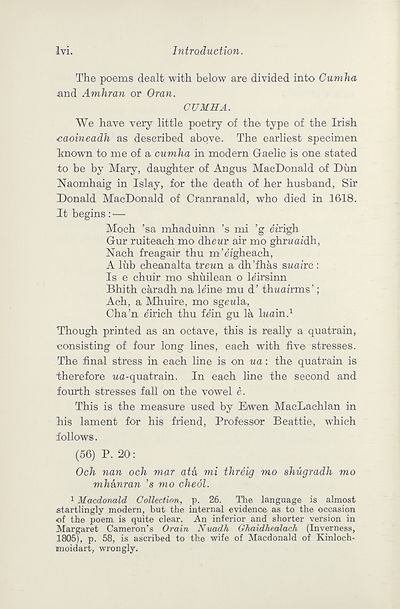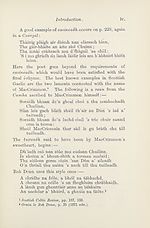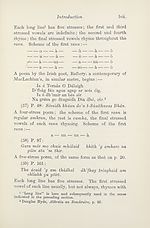Download files
Complete book:
Individual page:
Thumbnail gallery: Grid view | List view

Ivi.
Introduction.
The poems dealt with below are divided into Cumha
and Amhran or Oran.
We have very little poetry of the type of the Irish
caoineadh as described above. The earliest specimen
Tmown to me of a cumha in modern Gaelic is one stated
to be by Mary, daughter of Angus MacDonald of Dun
Naomhaig in Islay, for the death of her husband, Sir
Donald MacDonald of Cranranald, who died in 1618.
Moch ’sa mhaduinn ’s mi ’g eirigh
Gur ruiteach mo dhewr air mo ghrweudh,
Nach freagair thu m’eigheach,
A lub cheanalta treun a dh’fhas suaivc :
Is e chuir mo shuilean o leirsinn
Bhith caradh na le'ine mu d’ tbuairms’;
Ach, a Mhuire, mo sgeala,
Cha’n e’irich thu fein gu la Iwain.1
Though printed as an octave, this is really a quatrain,
consisting of four long lines, each with five stresses.
The final stress in each line is on ua: the quatrain is
therefore ■ua-quatrain. In each line the second and
fourth stresses fall on the vowel e.
This is the measure used by Ewen MacLachlan in
his lament for his friend, Professor Beattie, which
follows.
(56) P. 20:
Och nan och mar ath mi threig mo shugradh mo
mhknran’s mo cheol.
1 Macdonald Collection, p. 26. The language is almost
startlingly modem, but the internal evidence as to the occasion
of the poem is quite clear. An inferior and shorter version in
Margaret Cameron’s Grain Nuadh Ghaidhealach (Inverness,
1805), p. 58, is ascribed to the wife of Macdonald of Kinloch-
moidart, wrongly.
Introduction.
The poems dealt with below are divided into Cumha
and Amhran or Oran.
We have very little poetry of the type of the Irish
caoineadh as described above. The earliest specimen
Tmown to me of a cumha in modern Gaelic is one stated
to be by Mary, daughter of Angus MacDonald of Dun
Naomhaig in Islay, for the death of her husband, Sir
Donald MacDonald of Cranranald, who died in 1618.
Moch ’sa mhaduinn ’s mi ’g eirigh
Gur ruiteach mo dhewr air mo ghrweudh,
Nach freagair thu m’eigheach,
A lub cheanalta treun a dh’fhas suaivc :
Is e chuir mo shuilean o leirsinn
Bhith caradh na le'ine mu d’ tbuairms’;
Ach, a Mhuire, mo sgeala,
Cha’n e’irich thu fein gu la Iwain.1
Though printed as an octave, this is really a quatrain,
consisting of four long lines, each with five stresses.
The final stress in each line is on ua: the quatrain is
therefore ■ua-quatrain. In each line the second and
fourth stresses fall on the vowel e.
This is the measure used by Ewen MacLachlan in
his lament for his friend, Professor Beattie, which
follows.
(56) P. 20:
Och nan och mar ath mi threig mo shugradh mo
mhknran’s mo cheol.
1 Macdonald Collection, p. 26. The language is almost
startlingly modem, but the internal evidence as to the occasion
of the poem is quite clear. An inferior and shorter version in
Margaret Cameron’s Grain Nuadh Ghaidhealach (Inverness,
1805), p. 58, is ascribed to the wife of Macdonald of Kinloch-
moidart, wrongly.
Set display mode to:
![]() Universal Viewer |
Universal Viewer | ![]() Mirador |
Large image | Transcription
Mirador |
Large image | Transcription
| An Comunn Gàidhealach > An Comunn Gàidhealach Publications > Bardachd Ghaidhlig > (60) |
|---|
| Permanent URL | https://digital.nls.uk/126281852 |
|---|
| Description | This contains items published by An Comunn, which are not specifically Mòd-related. It includes journals, annual reports and corporate documents, policy statements, educational resources and published plays and literature. It is arranged alphabetically by title. |
|---|
| Description | A collection of over 400 items published by An Comunn Gàidhealach, the organisation which promotes Gaelic language and culture and organises the Royal National Mòd. Dating from 1891 up to the present day, the collection includes journals and newspapers, annual reports, educational materials, national Mòd programmes, published Mòd literature and music. |
|---|---|
| Additional NLS resources: |
|

